Tags: arepas, artichoke confit, Be Katsu, beefpho, Food porn, foodpornSpain, French food, goat cheese salad, Gourmet, gourmetfood, International food, jamon serrano, L'Etiquette, La Maja, more food porn, quiche, Restaurante Mi Casa, sesame seed croutons, Spanish food, Venezuelan food, Vietnamese food, You Lounge
These are some of my favorite food finds in the Costa Blanca area of Spain, including a couple of my own:
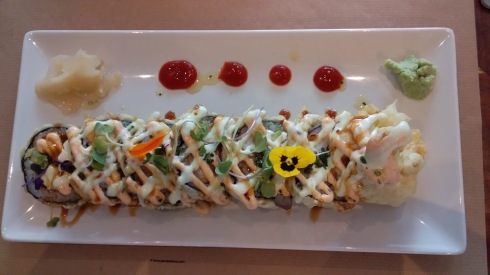
Jon Dragon Roll: Be Katsu. Albir; and other Vietnamese and Japanese food offerings (which I don’t remember the name of)
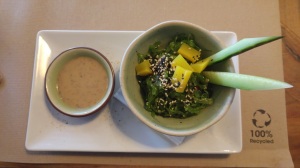
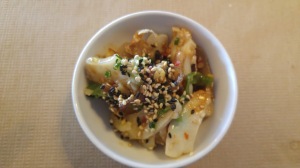
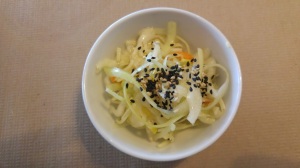
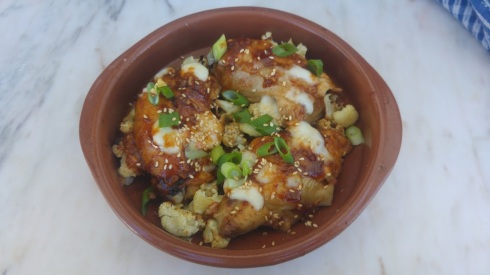
Homemade (casera) Korean crispy fried chicken, roasted cauliflower and other ingredients in spicy Korean gochujang sauce.
Tags: Albir, Albir restaurants, Alfaz, Altea, Altea restaurants, asparagus tortilla, avocadorolls, Be Katsu, Belgomar, bouillabaisse, Ca Pere, Ceeveceria Ca Pepi, Chopitos, comida casera, comida de Costa Blanca, Costa Blanca food, Dragon Roll, duck gizzard confit, escargots, French food, goat cheese salad, gojuchang, Hasaki Sushi, homemade, Japanese food, Korean crispy fried chicken, L'Etiquette, Ma Maison, miso chicken, misosambal chicken, redtunarolls, Rio Mundo, Sabor, sambal chicken, San Diego Mission, scallops, Sushi, Tapas, tortilla de esparragos, tunaavocadorolls, vieras, Vietnamese food
Mixed seafood: Calle Segovia, Sevilla
Tags: Alicante, Altea, arroz negro, bacalao, Casco Antiguo, Cola de rape, festivals, Food porn, lamb, lobster, Paella, Quality of life, Sant Pere festival, Spain, Spanish festivals, Spanish food, Spanish seafood, Tapas

La Favorita Taberna: Benidorm, tapa with serrano ham, crab and shrimp (tapa con jamon serrano, cangrejo y gamba)

House of Jarl, Altea, brunch with paté, chorizo, perfectly cooked egg, cheeses, salad, potato with creme fraiche and dill
Tags: Albir, Alfaz, Alicante, almejas, Altea, arcoiris, arroz negro, bacalao, Benidorm, black rice, Blau Bellaguarda, bogavante, Carpaccio, Cerveceria Casa Juan, cod, cordero, Food porn, Intermezzo, jamon bellota iberico, jamon serrano, La Capella, La Maja, lamb, lobster, Perro Negro, purple Peruvian potatoes, Quality of life, rainbow, roasted lamb, Sabor, Spain, Spanish food, Spanish seafood, Tapas, tortilla, Tragantua Gran Taberna
Day 4 with no running water in my apartment in Altea Spain. (No bueno.) Initially, I inquired of my two neighbors in the same building had water and they did not. My contacts with the property manager, Pacqui, at Ibis Inmobliaria, were unbelievably frustrating and unprofessional.
When I told her I did not have water for two days, she asked if I had paid the bill, even though the bill goes to her office, and then I pay it every month, so she should have known that. Then she asked if the neighbor had water and when I said no, she advised me to go to the water company for info. My Spanish is pretty good about daily matters but more challenging when trying to communicate about uncommon things. I asked here via text several more times, and she dismissively replied in Spanish that something must be broken. So when will I have water, I asked her in Spanish, and she said when it is fixed, and have a nice day with a smiley emoji. In spite of my repeated requests for information, she never gave me any idea what was wrong or when I would have water. Even when I told her I would look for a new apartment because I could not function without water or without knowing when I would have it, she did not respond.
Too bad I had recently just gotten rid my cupboards of all the empty bottles which I could have used to get water from the local fountains, which fortunately provide potable drinking water at many spots around town.
Finally, I found the emergency water hotline which I called on day 4. They asked me the same questions several times, i.e. how long have you been without water, and are your neighbors without water. Then they asked me why no one had reported it; apparently neither the property manager nor the neighbor who runs a barbershop bothered to call. During that time, I observed a man working on the street on a pipe, and about half an hour after my call I had water, but I think the restoration of water was a coincidence, not due to my call. After that, the water company called back and informed me the water would again be shut off for more repairs in three days, which although inconvenient, but I can handle it with advance info.
The lack of customer service and difficulty in accomplishing bureaucratic or business tasks is one of the most frustrating things about living in Spain. It took me almost two and half months to change my internet provider. You can’t just walk into a store and buy a cell phone, nor just cancel a service and return the equipment. And don’t be surprised if what they tell you to do is different each time you go back trying to fulfill their last requirement. All that said, I still love my life here in Spain, in spite of the occasional frustrations.
Tags: Daily life, Ibis Inmobliaria, No running water, Spain, Water fountain
I have decided to revisit some of my favorite meals and foods here in the Costa Blanca area of Spain:
Tags: Arab occupation, Calamari, Casco Antiguo, Chopitos, Cocido con pelotas, Conejo, Fish, Flan, Goat cheese, Jamon, La Maja, Octopus, Paella, Pimiento de padron, Pulpo, Queso de cabra, Rabbit, San Pedro, Seafood salad, Spanish food, Spanish seafood
Travelling requires planning, and then when things go awry, flexibility. I love living here in Altea, on the Mediterranean, in Spain, but I also want to continue my life-long love of travelling to new places.
To that end, I have been looking to explore nearby destinations, and places further afield in Spain and beyond. However, from where I live, it is often not easily accessible to other areas of Spain, and beyond. The local tram, now over 100 years old, is a major way to travel from Altea to the north to Denia and to the south to Alicante, and destinations in between. It is about an hour by tram from Altea to Denia and two hours south to Alicante. However, the tram has been undergoing upgrades, and so now only runs to Calpe, three stops north of Altea, and then you need to transfer to a bus which substitutes for the tram. I was going to Javea, (aka Xàbia) a little less than an hour north of Altea. While dogs are allowed on the tram, when I went to the local tram station and asked if I could take my dog on the bus, (since it was a substitute for the tram), she called to ask her superiors. She told me it was not allowed.
So I had already made Pepper, (aka Pimienta) my small dog, a portable carrier/backpack incognito, by tacking on black scarfs inside on the netting, so I could “sneak” him onto bus public transport. But when I took the tram from Altea to Calpe, and tried to transfer to the bus for destinations north beyond, I was told I had to leave the backpack in the luggage hold in the bus, (which is the same as the animal transport policy for public buses in Spain.) I could not leave the dog in the soft backpack in the luggage hold.
So I had to regroup. I ended up taking a taxi to Javea, for 48 €. Originally I booked the Parador in Javea (paradors being historical buildings converted into hotels and restaurants), but the booking website incorrectly said they allowed dogs. Then I booked The Hotel Rodat, also a 4 star hotel. It was a lovely hotel which reminded me much of hotels in the Santa Barbara area of California. Unfortunately for me, the dog-friendly rooms were down many stairs, (with no disabled access nor rails for the stairs) and no ability to eat in any of the hotel restaurants with your dog; in Spain, usually there is outdoor seating where pets are welcomed. I was planning to eat at their 1 Michelin star restaurant. The room service only had a limited menu, and did not include any dishes from the Michelin-starred restaurant and very few from the more casual dining restaurant. A dog-friendly hotel where you cannot eat at any of the restaurants? No bueno.
Thus I proceeded to the L’Arenal beachside region of Javea where I enjoyed some snacks of berberechos and lobster soup at Fontana Restaurant. The outdoor covered roof with gas heaters allowed a cozy view of the beach walkway and all of its activities. Afterwards, I walked about two miles to the port to Varadero restaurant and bar where Destry Spigner, a local blues and soul singer was performing. In addition to enjoying his performance, I had a tasty snack of Spanish cheese and hams.
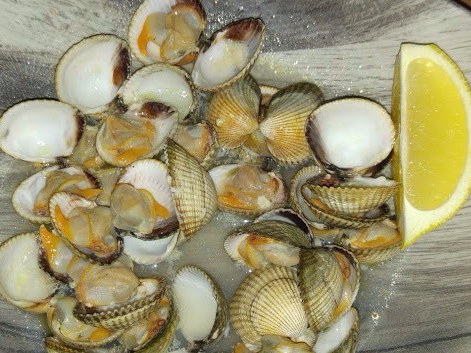
berberechos
After a restful night’s sleep, I enjoyed the garden area outside my room while Pepper played fetch. I then returned to Los Remos, a restaurant which had an enticing menu that I had seen the previous day, but was unable to eat at as the kitchen was closed after 4:00 p.m. until the dinner service. I am glad I returned as I had one of the best meals I have had in Spain, (bogavante azul) and superb mixed sautéed vegetables. While dining, I watched the busy beach area, with youngsters getting surf lessons (although there was hardly any surf), families walking and playing, and dogs running on the beach (which is not allowed in the summer, but tolerated in the winter.) Happy and sated with my outing, I returned to Altea via taxi, for the same 48€ that it cost me to get to Javea from Calpe.
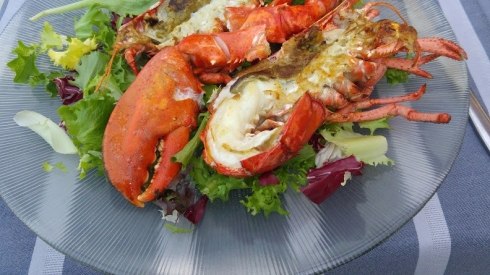
blue lobster (bogavante azul)
Tags: Altea, Beach activities, Berberechos, Blue lobster, Bogavante azul, Calpe, Cheese and ham plate, Denia, Destry Spigner, Fontana Restaurant, Hotel El Rodat, Javea, Los Remos Restaurant, Mediterranean, Michelin restaurant, Parador, Pepper, Pimienta, Soulja, Tram, Varadero, Xabia
I have long wanted to go to the historic, fortified walled city of Carcassonne, a UNESCO world heritage site, located in southern France, with its fairy-tale looking defensive double walls, castle, drawbridge, watchtowers and cobbled streets. Not only was I fascinated with it, I had read about and seen enticing photos of the five-star Hôtel de La Cité, located in the heart of the medieval citadel, and relished the idea of staying within the walled city. The hotel has the traditional, comfortable luxury that I favor, with inviting outdoor spaces and great views of the expansive valley below.
I had initially flown directly from Alicante, Spain to Toulouse, in the region of Occitanie, scheduling the first three days in Toulouse. For the fourth day, I booked the Hôtel de La Cité. Carcassonne is only a short, scenic 40 minute train ride from Toulouse. Unfortunately, I misjudged how long it would take to get from my hotel in Toulouse to the train station due to having to navigate around the old town and to get a ticket for my dog from an agent. Fair warning, I was able to book my seat on the train via the internet but not for my small dog, which had to be done in person at the train station. So I took the next train, an hour and a half later, with my small dog, Pepper, (AKA Pimienta) in his portable, wheeled carrier.
The train station in Toulouse had a piano permanently located in the waiting area, and many people spontaneously sat down and played. It’s these little serendipitous things that contribute to my passion for travel. There was also a foosball table, which kids and adults stopped to play. Be aware that in many train stations in France you need to get to your train by walking under the train tracks via stairs. If you have mobility issues and/or a heavy suitcase, it can be challenging. Allow extra time or if you are disabled, request help when booking your ticket.
Whenever I take public transportation like a train or bus, I try to go one timeslot earlier than my needed arrival time, in case something like this train trip goes awry. So even though I left an hour and a half later than initially intended, I still arrived on time at the hotel where I had scheduled to eat at the hotel’s Michelin star restaurant, Barbacane. Lunch was in the lovely garden area with views of some of the wall, watchtowers, and the valley below where Carcassonne residents now live. The prix fixe three course lunch which included two courses, each served with a glass of wine selected by the sommelier to pair with the food. Water was included and a choice of dessert or a cheese plate at the end, all for a quality, reasonably-priced meal of €39. Pepper sat quietly under the table.
After lunch, we went to my room, which was spacious, with elegant furnishings, a great bed and a menu offering a variety of pillows from which you can choose. Knowing I was bringing my dog, they gave me a room with stairs that led down to a garden area, where Pepper could do his outdoor duties. There also was a table and chairs on the upstairs patio. I was surprised and pleased to see they had a dog dish with water in the room ready for Pepper, the first time I have ever experienced that. And there was no extra charge for the dog, whereas normally there is.
After settling in to the room, I went out to explore the rest of Carcassonne within the walled citadel. The area is pedestrian with the exception of an occasional delivery vehicle, but it was very crowded with summer day trippers. There are a few buildings and museums worth exploring.
The Gothic-Romanesque Basilica Saint-Nazaire dates back to the 12th century and has beautiful stained glass. The rest of the buildings largely house touristic shops selling regional specialties including food (foie gras, cassoulet, truffles, and olives), local wines, knight-themed items, and cafes and restaurants. It felt more like a crowded theme park than a historic site. I had only booked one night at the Hôtel de la Cité, as I first wanted to see if I enjoyed it enough to stay longer; I was glad I did. I considered exploring some of the other areas of Occitanie, but ultimately decided to head back to Toulouse and explore it further.
I used the internet to find a last-minute hotel reservation for the next three nights in a different area of Toulouse than my initial stay. After I arrived, I told the taxi driver the name of my hotel, he said it was just a short distance, waving his hand toward a large boulevard. So I walked, and walked, and walked. The hotel was not straight down the street, and I wandered for a while, luggage and dog in tow in the heat. I stopped for a cooling beverage, where I could ask the staff for directions. Feeling slightly refreshed and optimistic, I again set off for my hotel. An unexpected finding was that there were three hotels within a two block area that had the same name as the one I booked. Well actually, the main name was the same, with a slightly different second name. I finally found my hotel, which I initially found shockingly spartan after my stay at a five-star hotel. After I got over my initial dismay, I found the room adequate, particularly as I don’t spend much time in my room, and it was a dog-friendly hotel. I spent the next three and a half days in Toulouse exploring different neighborhoods, historic sites, and scouting out delectable food. I am already thinking about a return trip to Toulouse.
Tags: art, Barbacane, cassoulet, foie gras, Food porn, French food, Hotel de la Cite, Michelin star restaurant, Pepper, Pimienta, Quality of life, Saint-Nazaire, sommalier, Truffles
Living in Spain provides me the luxury of being able to travel to nearby places, like Europe and Africa, at very inexpensive costs. I initially explored the idea of travelling in central Spain this August, but it was too hot, and then Prague and Budapest, but the direct flights from where I live were not available in August. Preferring direct flights, which have a decreased chance of delays, I explored other options and decided to go to Toulouse and nearby Carcassonne, which are at the base of the Pyrenees in southern central France, not far north of Andorra. The flight is only about an hour each direction, which cost me €61 each direction, and €72 round trip for my small dog, who traveled in the cabin under the seat in front of me. I spent a week in the Toulouse area.
Toulouse is the fourth largest metropolitan area in France, and the Occitanie area (formerly Languedoc-Roussillon) in which it and Carcassonne are located is the largest geographical region in France. Toulouse is known as the “pink city,” due to the many buildings made of pink stone and bricks. It is a walk-friendly city with distinct neighborhoods, which are the types of large cities I favor. When I first arrived, I stayed for three days at the Grand Hotel Opera, centrally-located on the large Capitole Plaza. It was a good starting spot, with cafes and restaurants serving drinks, snacks and higher-end cuisine. I do not like shopping, but there were a variety of shops/stores on or near the plaza, surprisingly including a number of U.S. stores like Sephora and Foot Locker, and other popular European stores.
Before I arrive at vacation destination, I try to get a basic familiarity with the areas and places I would most like to visit. I am a foodie, so I read up on the typical regional cuisine, recommended restaurants, as well as live entertainment. Obviously once I arrive, I get a better feel for the area, and make my plans accordingly, but I leave room for a great deal of spontaneity which can result in serendipitous finds. One such occasion occurred when I walked to the local fruit and vegetable market, where I decided to have lunch at one of the many nearby restaurants. I noticed it was cloudy and looked like it could rain, so I found a restaurant, Le point Gourmet, with a good awning coverage of the outdoor area, and most importantly, good food. I was too late to get the daily special of duck hearts, fresh from the market, as they were already sold out. But my duck breast, duck-fat fried pommes frites (French fries), and salad were delicious.
While sitting at the restaurant and waiting for my food, it started raining. Many of the diners not under cover frantically arose, trying to grab food, beverages and belongings. Most handled it with aplomb and humor, but one family where I was dining, got into an argument with the owner, which became quite heated. After they diners left, the French owner, who spoke very good English, (I only speak English and Spanish), said the three patrons were blaming him for the rain, and he replied he was not God. He correctly mentioned that there was only a brief rain, and the patrons nonetheless said they would not pay for the food. There was some more heated discussion, with their continued verbal attacks and complaint about their mother being disabled, to which the owner said his wife, who was still working long hours at the restaurant, had cancer. They finally left. The owner then told me the following story: “God made France, with beautiful landscapes, oceans, vegetation and so on. When he finished, God said, France is perfect, everything. It is too perfect, so I am going to put French people there.” Hilarious!
The food in the Toulouse area is regionally-based, as is common in Europe. They are famous for their cassoulet, foie gras, sausages, many types of offal (veal kidneys, gizzards, hearts, and sweetbreads), fantastic variety of cheeses, predictably delicious bread and baked goods. Most places offer quality, affordably-priced prix fixe menus, not as inexpensive as where I live in Spain, but far cheaper than you would pay for comparable food in the U.S. Also, the regional wines are excellent, usually inexpensive, and frequently available in varying amounts like 15 ml, 50 ml, and 75 ml (respectively, a glass, a little more than a half bottle, and a full bottle.) For those who live in Spain, Toulouse does not cafés on every block or even several on every block like there are in Spain, which I realized when I looked for a place to duck into when it started to rain.
The other thing I did not anticipate were the operating and closing hours for businesses, with many shops closed either in the afternoons or early in the evening, and also many places, including restaurants, are closed on Sundays, holidays and during parts or all of August. I failed to check the holiday schedule before I booked my vacation, only to learn that there was a religious holiday, Assumption Day, in which many businesses were shuttered.
The Toulouse and greater Occitanie area offer numerous entertainment and outdoor activities. In Toulouse, there are the expected ancient and historical buildings and museums. There was a jazz concert series during the summer featured such icons as George Benson and Wynton Marsalis. The Garonne River and Canal du Midi offer great spots for events and leisure. There and in the Montagne Noire, nearby mountain range, offer opportunities for outdoor and physical activity enthusiasts. Winery tours in the region is another popular and easy day trip from Toulouse. Toulouse also boasts Europe’s largest space center, which also offers venues oriented toward children.
After my first three days in Toulouse, I took the short 45 minute train ride to the walled city of Carcassonne, where I spent the night, at the fabulous 5-star Hôtel de la Cité and ate at their Michelin-star restaurant, Barbacane, which I will write about in a subsequent blog post. I also plan to share my restaurant reviews from Toulouse which I will publish on TripAdvisor: they recently reported I have over 100,000 readers of my reviews!
Tags: art, Barbacane, Canal du Midi, Capitole Plaza, cassoulet, Duck, duck confit, festivals, foie gras, Garonne River, Grand Opera Hotel, Hotel de la Cite, jazz, Le point Gourmet, Montagne Noire, Music, Prix fixe, Quality of life, salade gourmande, Spain, The Pink City, Toulouse activites, Toulouse Space Center, Trip Advisor, U.S. stores in Toulouse, Wineries
Due to popular demand, I am re-posting my series of blogs about how to get a “non-lucrative (retirement) visa to live in Spain. I have just completed my second renewal, which was considerably easier than my initial application, mostly owing to my experience at submitting the correct documents. Here is my most recent visa, with personal info redacted:
At the time of my first post in July 2015 about the process of how, as a U.S. citizen, to apply for a non lucrative residential or retirement visa to reside in Spain when I discovered this excellent and informative blog post by Jed on www.bucking-the-trend.com on February 17, 2014. So with his permission, I instead posted his blog, and then added my experiences where they were different. I was surprised to learn the requirements vary depending on which Spanish consulate you are required to apply. Here is Jed’s post:
How to Apply for Non Lucrative Visa for Spain as US Citizen – Bucking the Trend.
MY EXPERIENCES IN APPLYING FOR A “RESIDENCE FOR RETIREE” VISA
The process for applying for a non-lucrative visa to live in Spain as a U.S. citizen varies with which consulate you are required to go through. WHAT??? I thought the process would be the same since it is a national visa, but with some research online, and then personal experience, I was surprised to learn the requirements were sometimes different.
My first inkling about this came when I tried to inquire from the Spanish consulate in Los Angeles about the requirement of providing documentation of having a place to live in Spain, yet having to be in the U.S. to apply for and wait for the visa. I had read a number of stories about the capriciousness of whether or not visas were issued by the Spanish government, so I was reluctant to rent a place in Spain without an assurance of being issued a visa. Moreover, I did not want to pay for a place which would sit empty for many months or possibly until the lease expired. When I initially contacted the L.A. consulate and naively asked how I was supposed to be in the U.S. yet have a permanent address in Spain, I was simply told I had to do everything required on the application.
When I inadvertently got on the San Francisco Spanish consulate website, there were different requirements, with no mention of the need for documentation of housing ahead of time. I wrongly assumed that the requirements would be the same across consulates, so I again contacted the Los Angeles consulate, (my mandated consulate based on living in San Luis Obispo County), noting that the San Francisco consulate did not have the housing requirement so did I have to at the L.A. consulate, to which I received the same response as my first contact with them, that I must do everything required on the application. They added that the requirements can vary depending on the consulate.
So I “relocated” to the San Francisco Bay Area with my son, and with my new address in Marin County, I submitted my visa application, sans documentation of a place in Spain to live. Interestingly, after booking my appointment via internet to submit my visa documents, when I showed up for my scheduled appointment, the man asked about my housing documentation. In my best, albeit slow Spanish, I smiled and explained that I did not yet have a permanent place to live in Spain because I would do that as soon as I arrived. Apparently, that was acceptable to him. Although it should go without saying, bring patience and politeness to your appointment at the consulate. I have seen curt and even rude people, whose behavior interfered with achieving their goal of getting a visa.
Also, on the San Francisco consulate’s website, they had a specific application “Residence Visa for Retirees,” which the L.A. website did not, although the requirements are largely the same with the exception of the variation between consulates. There are additional documents required to submit for those with a spouse and/or children.
There is a requirement to have all documents translated into Spanish. Living in California with many translators, I thought that would be easy. However, as with any time one deals with the Spanish bureaucracy, things were not that simple. I inquired as to whether a certified Spanish interpreter in California would qualify, and was told, it depended. The Spanish government may or may not accept the translation. As there were many documents that needed translation, including the reasons you want to move to Spain, criminal history check, medical certificate, medical insurance with no deductible, proof of minimum retirement income, with some documents requiring notarization, I tried to find a translator who was certified by the Spanish government. The first person I found was located in Spain, and after she learned I was in the U.S., she said she could not do the translation. The Spanish consulate website had a link to interpreters, but it was not working. I finally got someone at the consulate to send me the list of certified translators. One was conveniently located in the San Francisco Bay Area, and we exchanged documents by mail. She was fabulous, quick and met all translation requirements.
There were also some deadlines about how long you had to retrieve your visa from the consulate once notified of approval and to travel to Spain. One has to show proof of flight/travel arrangements when retrieving your visa, and the travel has to be scheduled within a short time, which generally means high flight costs. I got my notice of approval of my visa just shy of three months after I applied, and was required to pick it up within a few weeks. My flight to Spain was two months later.
In my next posts, I will discuss taking a pet to Spain, the procedures required once in Spain to actually get your Residential Visa/NIE card, and the first renewal of my Spanish visa.
Tags: Applying for Residential Visa in Spain, Non-lucative Spanish visa
Experiential travel emphasizing local culture, food and music
How I went from working as a writer in New York City to co-owning a bar in Spain
Blog about our adventures as world travelers and expats living in Colombia.
My journey around the world
Travel inspiration, stories, photos and advice












